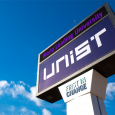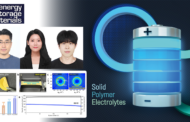A new type of semitransparent organic solar cell (ST-OSC) with an efficiency of over 10% has been developed, bringing us closer to a future where windows and mobile display screens could function as invisible power sources.
Professor Changduk Yang and his research team from the School of Energy and Chemical Engineering at UNIST announced the development of ST-OSCs, featuring a power conversion efficiency (PEC) of 10.81% and a visible light transmittance of 45.43%.
While traditional solar panels installed on rooftops or along roadsides appear dark because they absorb sunlight to generate electricity, transparent solar cells must allow most light to pass through without absorption. Developing highly efficient transparent devices has therefore been a significant challenge.
The key to this innovation lies in a specially designed photoactive layer that selectively absorbs only infrared wavelengths. This layer transmits nearly half of the visible light spectrum while harvesting energy from the invisible infrared portion of sunlight to produce electricity.
 Figure 1. The symmetric molecular structure of 4FY has been shown to induce an asymmetric molecular interaction, which promotes a higher degree of molecular packing than in Y6. The asymmetry-driven molecular interactions can be leveraged to fabricate large-area semitransparent organic solar modules that are efficient and stable under realistic operating conditions. An image on the far right is a campus photo with ST-OSM.
Figure 1. The symmetric molecular structure of 4FY has been shown to induce an asymmetric molecular interaction, which promotes a higher degree of molecular packing than in Y6. The asymmetry-driven molecular interactions can be leveraged to fabricate large-area semitransparent organic solar modules that are efficient and stable under realistic operating conditions. An image on the far right is a campus photo with ST-OSM.
Typically, capturing infrared light results in lower efficiency compared to absorbing high-energy visible photons. However, the team overcame this obstacle through innovative molecular design of the active layer’s receptor molecules. The active layer in OSCs consists of donor and acceptor molecules that facilitate charge transfer.
The newly synthesized acceptor molecule, called 4FY, is generally symmetrical and features an A–D–A structure. Nonetheless, it was intentionally designed to induce localized asymmetry—specifically between fluorine and hydrogen atoms, and fluorine and sulfur atoms—that enhances molecular alignment and improves charge transport, leading to higher device efficiency.
First author Sangjin Yang explained, “While asymmetry can boost efficiency, it often reduces device lifespan and complicates synthesis.” He added, “Our molecular design introduces localized asymmetry within an overall symmetrical structure, leveraging the advantages of both.”
The device demonstrated impressive durability, maintaining most of its initial performance during a 134-hour outdoor cycling stability test that simulated day-night conditions. This durability is approximately 17 times greater than that of previous semi-transparent OSCs based on Y6 acceptor molecules.
Professor Yang commented, “We introduced a new approach to generating electricity from invisible light,” adding, “This technology has potential applications in smartphone protective films, building windows, and transparent displays—effectively turning everyday surfaces into invisible power plants.”
Their findings were published in Angewandte Chemie International Edition on June 10, 2025. This study was supported by the Ministry of Science and ICT (MSIT), the National Research Foundation (NRF) of Korea, the Korea Institute of Energy Technology Evaluation and Planning (KETEP), and other agencies.
Journal Reference
Sangjin Yang, Xuexiang Huang, Yongjoon Cho, et al., “Efficient Semitransparent Organic Solar Modules with Exceptional Diurnal Stability Through Asymmetric Interaction Induced by Symmetric Molecular Structure,” Angew. Chem. Int. Ed., (2025).













